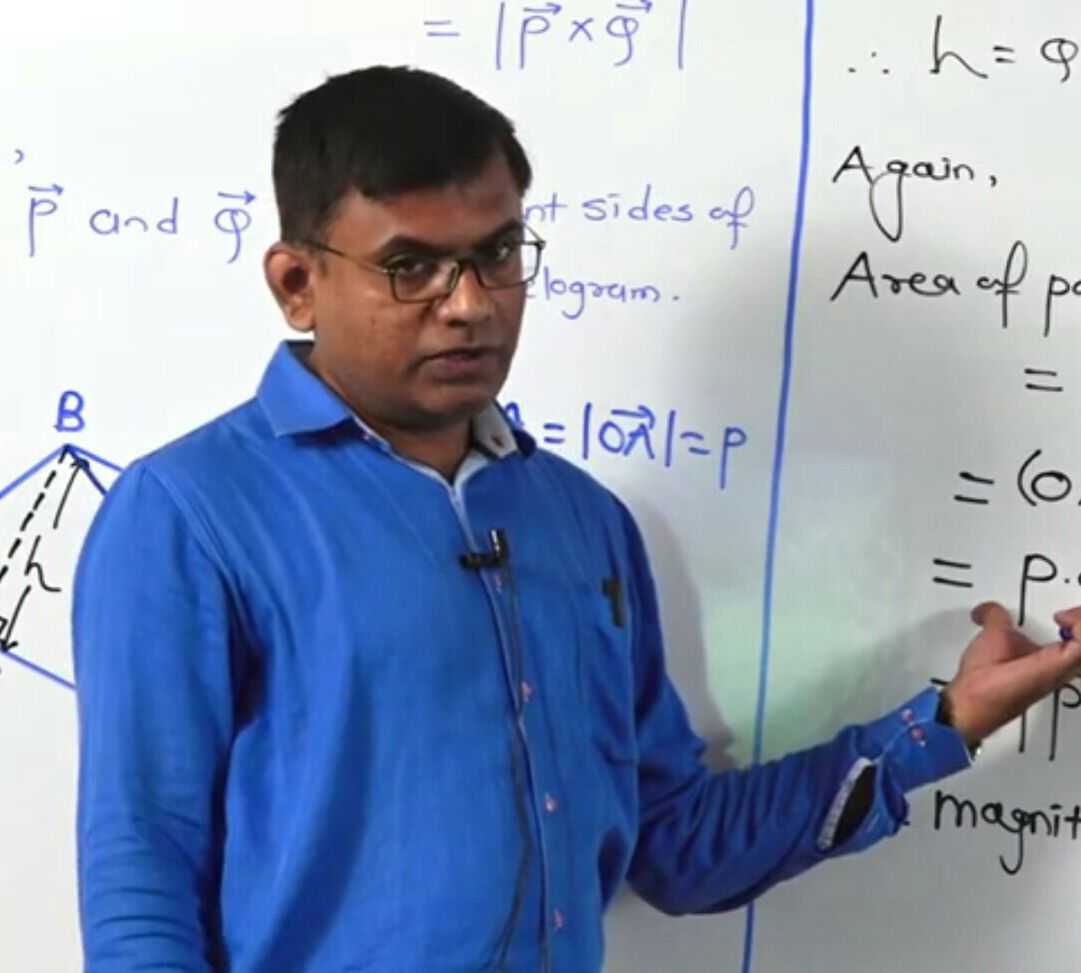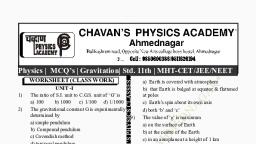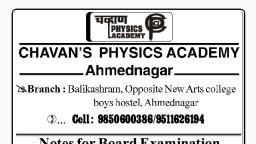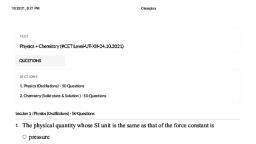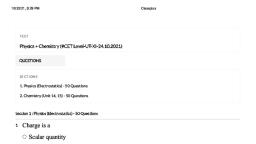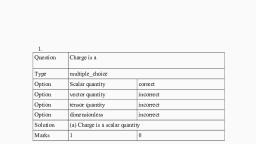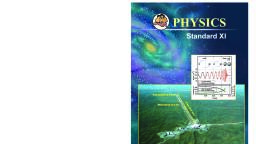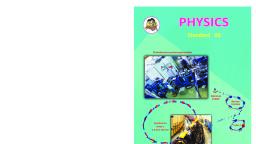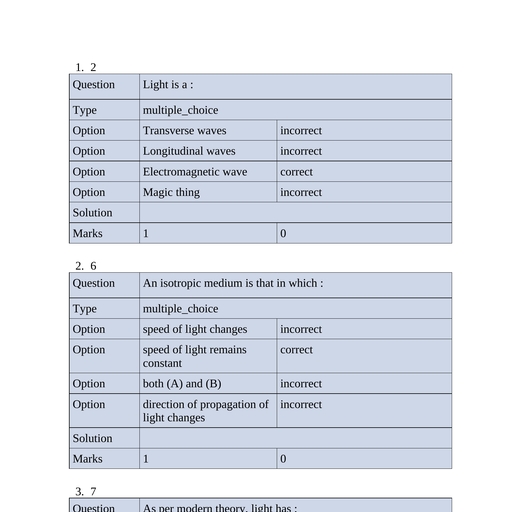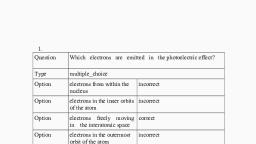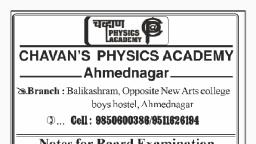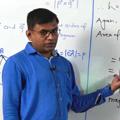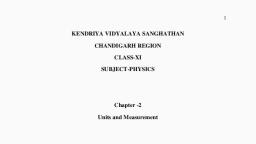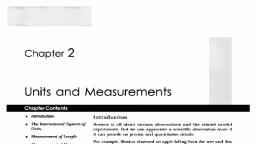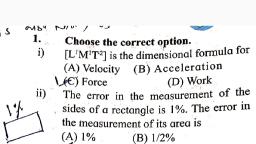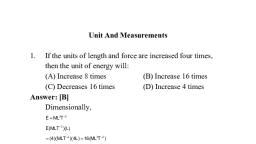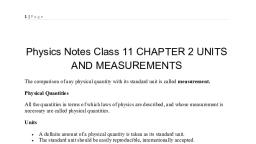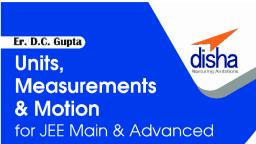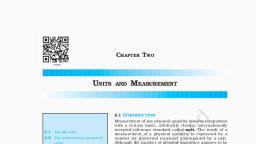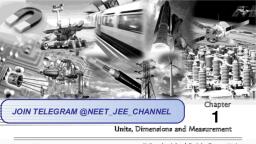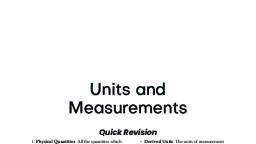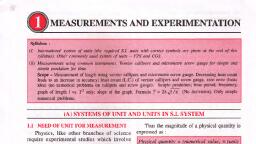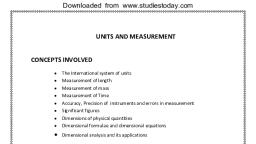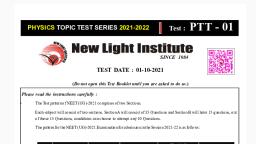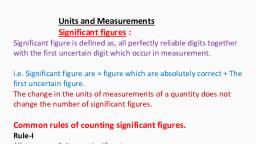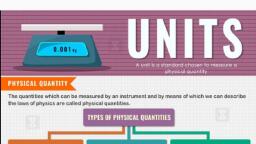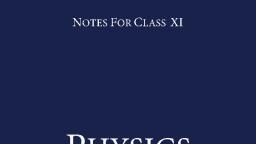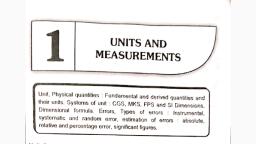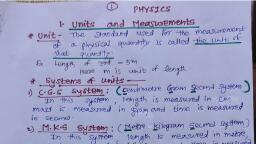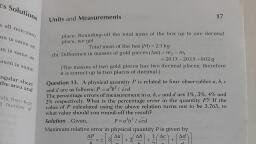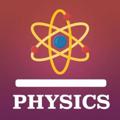Page 1 :
11th (Sci.) Unit and Measurements., , Page 1
Page 2 :
Units and Measurements, * Physics is the branch of science which deals, with the study of nature and natural, phenomenon., *, , The quantities which can be measured in, physics are called as physical quantities., * The physical quantities which do not depend, upon other physical quantities for their, measurement are called as fundamental, physical quantities., * The physical quantities which depend upon, one or more fundamental quantities for their, measurement are called as derived physical, quantities\, * The standard used for the measurement of, physical quantity is called as unit of that, quantity., * There are seven fundamental quantities i.e., Mass, length, time, temperature, electric, current, luminous intensity and amount of, substance., * Except seven fundamental remaining all are, derived quantities., * A measurement is a comparison with, internationally accepted standard., * The measured quantity (M) is expressed in, terms of a number (n) followed by a, corresponding unit (u) i.e. M = nu, e.g. Length of meter wire = 2m, * System of units :, There are four systems of units., 1) CGS System – It stands for centimeter-Gram, second system. Length, mass and time are, measured in centimeter, gram and second., 2) MKS system – It stands for meter- kilogram, and second system, Meter – unit of length, Kilogram–unit of mass, Second- unit of time., 3) FPS system – It stands for foot-pound-second, system, 4) SI system – It stands for system International., After 1971 this international system is, accepted all over the world. It consists of, seven fundamental and remaining all derived, units., 11th (Sci.) Unit and Measurements., , Fundamental units :, The units used to measure fundamental quantities, are called as fundamental units., Fundamental quantity SI unit Symbol, Mass, ki logram, kg, Length, , meter, , m, , Time, Temperature, Electric current, , second, kelvin, ampere, , s, K, A, , Luminousintensity, Amount of substance, , Candela, mole, , Cd, mol, , Derived units : The units of derived quantities, which are expressed in terms of fundamental units, for their measurements are called as derived units., Derived, quantity, , Formula, , SI unit, , Displacement, meter, time, sec ond, velocity, 2.Acceleration, m / s2, time, 3.Momentum mass velocity kg m / s, 1.velocity, , CGS unit, cm / s, cm / s 2, g cm / s, , Supplementary units :, 1) Plane angle :, The ratio of length of arc(ds) of circle toit’s, radius is called plane angle (d ), ds, d, r, , Hence d is angle subtended by the arc at, the centre of circle. It’s SI unit is radian, *The plane angle subtended by entire, 2 r, 2 c, circle at it’s centre =, r, 2) Solid angle :, i) solid angle is 3-dimensional analogue of plane, angle, solid angle is defined as the area of a portion of, ii) the surface of sphere to the square of radius of, sphere., dA, Formula : d, r2, iii) It’s units is steradian (sr), iv) solid angle subtended by entire sphere at it’s, centre, Page 2
Page 3 :
dA, r2, , 4 r2, r2, , 4 sr, , * Conventions followed while using SI units :, 1) Full name of a unit always starts with small, Initial letter, even if it is named after a person., e.g. N- Newton, J- joule etc., 2) Symbols of unit are never written in plural, Form., 3) Symbols do not contain full stop or punctuation, marks, 4) The prefix symbol is used before symbol of, unit. Hence prefix symbol and unit symbol, constitute a new symbol for unit., e.g. 1 ms = 1 millisecond = 10 3 s, 6, 1 s = 1 microsecond = 10 s, , D, *, i), , b, ………….(, D, b, , in radian ), , Using above formula ‘D’ can be measured., Some units used by astronomers for measuring, large distance, He astronomical unit (Au) is the mean distance, between centre of earth and centre of sun 1, astronomical unit (AU) = 1.496 1011 m, A light year is distance travelled by ray of light, , 1ns = 1 nanosecond = 10 9 s, 5) Use of double prefixes is avoided when single, Prefix is available, e.g. 10 6 s = 1 s and not 1 mms, 6) Space or hyphen must be introduced while, Indicating multiplication of two units., e.g. m / s should be written as m s 1 or m s 1, , ii), , but not ms 1, Measurements of large distance :, Small distance are directly measured using, Instruments like meter scale but large distance, cannot be measured directly. Some indirect, methods like parallax methods are used for it., 1) Parallax – parallax is defined as the apparent, Change in position of an object due to change, in position of an observer., 2) Parallax angle – Angle between two directions, along which a star or planet is viewed at two, points of observation is called parallax angle., b, D, 3) Parallax method is used to determine distance of, different planets from earth. The planets should, be visible from A and B which are points of, observations i.e. observatories., 4) ‘D’ is distance of planet from earth surface. A, and B are separated by ‘b’ i.e. AB = b, 5) Let ' ' is angle between two directions of, Observations ASB D, 6) We know that b<< D, , Measurements of mass :, i), Since 1889, a kilogram was the mass of shiny, piece of platinum- iridium alloy kept in a special, glass case at the international Bureau of, weights and measures., , 11th (Sci.) Unit and Measurements., , iii), , in one year 1 light year = 9.46 1015 m, A parsec (pc) is distance from where 1 Au, subtends angle of 1 second of arc, r, , ii), , iii), iv), , 1AU, (1'')c, , 1.496 1011, 4.847 10 6, , 3.08 1016 m, , This definition of mass was modified on 20th, may 2019. The reason being that platinum –, iridium alloy pick-up micro particles of dirtand, it’s mass get changed., The new measure of kilogram is defined in, the terms of electric current., One kg mass can be described in the terms of, amount of electric current which has to be, passed through an electromagnet so that it can, pull down one side of an extremely sensitive, balance to balance the other side which holds, one standard kg mass., , v), , While dealing with mass of atoms and, molecules, kg is inconvenient unit. Therefore, their mass is measured in atomic mass unit., , Page 3
Page 4 :
vi), , The, , 1, 12, , th, , mass of an unexcited atom of, , b), , L1 M 0 T, , velocity, Time, , Acceleration, , T1, , C12 is called atomic mass unit (amu)., 1amu 1.6605402 10, , 27, , L1M o T, , kg, , c), , Measurement of timei), SI unit of time is second (s). For many years, mean solar day duration was considered as, reference for time. The mean solar day is, thetime interval between one noon to the next, noon., ii) Average duration of day is taken as 24 h, Mean solar day = 24 h, = 24 60 min, = 24 60 60 sec, = 86400 s., iii) Accordingly a second was defined as, 1, of a mean solar day., 86400, iv) But mean solar day duration varies gradually, due to gradual slowing down of earth rotation., Hence to get standard and constant (non, varying) unit for measurement of time, a, Cesium atomic clock is used. It is based on, periodic, v) In cesium atomic clock a second is taken as, the time needed for 9, 192, 631, 770vibrations, of the radiation (wave) emitted during a, transition between two hyperfine states of, , 1), , 2), , 3), , Cs133 atom., Dimensions and dimensional analysisDimensions of a physical quantity are the, powers to which fundamental units must be, raised in order to obtain the unit must be, raised in order to obtain the unit of given, physical quantity., Dimensional formula: When any derived, quantity is represented with appropriate, powers of symbols of fundamental, quantities such expression is called, dimensional formula., Examples of dimensional formula, Dis tan ce, a) speed, time, Dimensions of speed, , [L], [T], , L1M o T, , 11th (Sci.) Unit and Measurements., , 1, , 1, , Force, , mass Acceleration, , = [M1 ] L1 T, = M1L1T, d), , e), , 2, , 2, , Im pulse, , = L1M1T, , Force time, 2, , T1 = L1M1T, , L1M1T, , Force, , pressure, , 1, , work, , 2, , L2, , Area, , L 1 M1 T, , f), , 2, , 2, , force displacement, , L1M1T, , 2, , = L2 M1T, , 2, , L1, , Uses of dimensional analysisI) To check the correctness of physical equations., If the dimensions of all the term son both the, Sides are same then that equation is said to be, dimensionally correct., - This is called as principal of homogeneity of, dimensions., V u at, LHS, , V, , L1M 0 T, , RHS, , u, , at, , LHS, , 1, , L1M 0 T, , 1, , RHS, , II) To establish (derive) the relationship between, related physical quantities., Ex- Relation between time period (T) of, Oscillation of simple pendulum, it’s length (l), and acceleration due to gravity., depends, Let Time period (T) =, length (l) and g, upon, T ( ) a (g) b, T k ( ) a (g) b ……………(1), , Where, k constant of proportionality., k has no dimensions., Using dimensions in equation (1), T, , a, , g, , b, , Page 4
Page 5 :
L0 M 0T1, 0, , 0, , L1M 0 T 0, , 1, , a, , 0, , LM T, , LM T, , L0 M 0 T1, , La, , b, , a, , 0, , L1T 2 M 0, b, , 2b, , LT, , M0 T, , M, , b, , X, , 0, , T K( ) (g), , 1, 2, , K( ), , 1, 2, , 103 g, g, , T, , K, K, , 1), , 1, 2, , 2), , 3), , g, 2, , T, , III), , 2, , 4), g, , To find conversion factor between the units of, the same physical quantity in two different, system of units., ExamplePhysical quantity work, SI unit, joule, CGS unit, erg, let 1 joule = x erg ………..(1), where, X conversion factor., Dim. Of work = M1 L2 T, , *, , i), , 2, 1, , 2, , X M12 L2 2 T, , 2, 2, , Suffix 1 SI, Suffix 2 CGS unit, Here,, M1 kg, M 2 gram, , L1, , meter L2, , centimeter, , T1, , second T2, , second, , X, , M11 L21 T1 2, M12 L22 T2 2, , 11th (Sci.) Unit and Measurements., , 2, , s, s, , 2, , ii), , 2as, , LHS, , V2, , RHS, , as, , L2 M 0 L 2, a s L2 M 0 L 2, , Correct But actual equation is V2 u 2 2as this, confirms a dimensionally correct equation need, not be actually a correct equation, Consider equation, 1, mv mgh, 2, L1M1 T, , LHS, , mv, , RHS, , mgh, , M1, , L1 T, , L2 M1 T, , hence, , 102 cm, cm, , 2, , s, s, , Limitations of dimensional analysis –, Value of dimensionless constant can be, Obtained with the help of experiments only., Can not be used to derive relations involving, Trigonometric, exponential and logarithmic, functions as these quantities are dimensionless, This method is not useful if constant of, Proportionality is not a dimensionless, quantity., If the correct equation contains some more, terms of same dimensions their presence using, dimensional equation can not be found out., A dimensionally correct equation need not, actually be a correct equation but, dimensionally, incorrect, equation, is, necessarily wrong – Justification., Consider equation, , V2, , Using dimensions in equation (1), M11 L21 T, , 2, , 2, , 1 joule 107 erg, , g, , Experimentally K, , m, cm, , T1, T2, , 107, , 1, 2, , T, , 1, , 2, , 103 104, , 1, g, , L1, L2, , 1, , kg, gram, , 2b, , Comparing powers of M, L and T, 1, T1 T 2b, a, 0, a b, 0, L, L, 2, 2b 1, 1, a b 0, 1, a, b, 2, 2, Putting values of a and b in equation (1), 1, 2, , 1, , M1, M2, , LHS, , 2, , 1, , m g h, , L1, , 2, , RHS, , Since above equation is dimensionally, Page 5
Page 6 :
*, i), , ii), , Incorrect, it must be dimensionally wrong., Order of magnitude –, The order of magnitude of a physical, quantity is defined as the value of its, magnitude rounded off to the nearest integral, power of 10. Or power of the ten nearest to the, number., To find the order of magnitude of a physical, quantity, it is first expressed in the form:, , P 10Q where, P is a number between one and, ten and Q is an integer (Positive or negative )., P 10Q = Magnitude of any physical, quantity, where P is a number such that, 0.5 P 5 and Q is an integer, called order of, magnitude., iii) If P is 5 or less than 5, the power of 10 is, increased by I to get the order of magnitude ., Examples :, a) speed of light in air = 3 108 m / s, order of magnitude= 108 m / s.( 3 5), b) mass of an electron = 9.1 10, order of magnitude= 10, , 30, , 31, , kg., , kg ( 9.1 5), , Order of magnitude of the some physical, quantities –, Sr, , Physical, , nu, , Quantity, , i), , Radius of, the earth (R), , ii), , Mass of the, earth (M), , iii), , Charge on, electron (e), , iv), , One year, , Order of magnitude, 6400 103 m 6.4 106 m, , R, , The number 6.4is more than 5, Order of magnitude 107 m, M 5.98 1024 kg 5.98is greather, than 5, order of magnitude 1025 kg, e 1.6 10, , 19, , C., , Order of magnitude 10 19 C, One year 365 24 3600second, 31536000second, 3.1536 107 second, Order of magnitude 107 second, , Universal, v), , gravitational, constant, , G, , 6.67 10, , 11, , Nm 2 / kg 2, , Order of magnitude, 10, , 10, , Nm 2 / kg 2, , 11th (Sci.) Unit and Measurements., , Some other physical quantities:, Sr.nu, , Physicalquantities, , Order of magnitude, , i), ii), iii), , Mass of thesun, Mass of an electron, Distance of the sun from earth, , 1030 kg, 10 30 kg, 1011 m, , iv), , Distanceof the moon from earth, , 108 m, , v), vi), vii), , Diameter of proton, Life time of an excited atom, Size of atom, , viii), , Sizeof nucleus, , ix), , Size of our galaxy, , x), , Mass of atom, , 10, , 15, , m, , 10 8 m, 10 10 m, 10, , 15, , m, , 21, , 10 m, 10, , 26, , kg, , Significant figures –A figure which is of some, significance but it does necessarily denote a, certainty is called a significant figure., * Rules for determining significant figures :, i) One and only one uncertain (doubtful) figure is, retained in measurement. In a reading of 2.64 cm,, only the figure 4 is uncertain., ii) When a number is to be rounded off to a, specific number of significant figures, then, a) If the figure to be rounded off is five or greater, than five, then the last digit retained is increased, by one., e.g. 12.46 should be written as 12.5., b) If the figure to be rounded off is less than 5, then, the last digit retained is left unchanged., e.g. 12.43 should be written as 12.4., iii) The zeros on the left of the number are not, significant., e.g. the number 0.0034 has only two significant, figures., iv) The zeros on the right side number are, significant, because, they, indicate, the, accuracy of the instrument used for, measurement., e.g. 2.40 and 2.400 represent the same number but, they are not equivalent. In 2.40 there are three, significant figures and 2.400 has four significant, figures., v) If the number of digits is more than the number of, significant figures, the number should be, expressed in the power often. Thus the mass of, the earth is written as 5.98 1024 kg, as it is, known only upto 3 significant figures., * Rules for rounding off the numbers of the, significant :, i) While rounding off numbers in measurement,, following rules are applied., If the digit to be dropped is smaller than 5, then, the preceding digit should be left Is unchanged., e.g. 7.34 is rounded off to 7.3, ii) If the digit to be dropped is greater than 5, then, the preceding digit should be raised by 1., *, , Page 6
Page 7 :
iii), , iv), , v), , *, i), ii), , iii), iv), v), , *, i), , ii), , iii), , *, 1), i), , e.g. 17.26 is rounded off to 17.3., If the digit to be dropped is 5 followed by, digits other than zero, then the preceding digit, should be raised by 1., e.g. 7.351, on being rounded off to first, decimal becomes 7.4., If the digit to be dropped is 5 or 5, followed by zeros, then the preceding digit is, not changed if it is even., e.g. 3.45, on being rounded off, becomes 3.4., If the digit to be dropped is 5 or 5 followed by, zerps, then the preceding digit israised by 1 if, it is odd., e.g. 3.35, on being rounded off, becomes 3.4., Accuracy :, Accuracy is the closeness of the measurement, to the true or known value, Accuracy of the measurement depends upon, the accuracy of the instrument used, for, measurement., Defect in measurement of physical quantities, can leads to errors and mistakes., Lesser the errors, more is the accuracy in the, measurement of a physical quantity, For example, when we measure volume of a, bar the length is measured with a metre scale, whose least count is 1 mm. Thebreadth is, measured with a vernier caliper whose least, count is 0.1 mm. a vernier calliper whose least, count is 0.1 mm. Thickness of the bar can be, measured with a micrometer screw gauge, whose least count is 0.01 mm., Concept of error :, The difference between measured value and, true value of a physical quantity is called, error., It is the uncertainty in measurement of a, physical quantity., Error = measured value – True value, Error are classified into following four groups:, a) Instrumental error (Constant error), b) Systematic error (Persistent error), c) Personal error (Human error), d) Random error (accidental error), Types of error :, Constant (instrumental ) error :, If the same error is repeated every time in a, , iii), , 4), , Example: If a thermometer is not graduated, properly i.e. one degree on the thermometer, actually corresponds to 0.99 o , the temperature, measured by such a thermometer will differ, from its value by a constant amount., In order to minimize constant error,, measurements are made with different accurate, instruments., Systematic errors :, Those errors which occur due to defective, setting of an instrument is called systematic, error., These errors are due to known reasons i.e fault, in instrument, improper attention, change in, condition, etc ., ex- if the pointer of an ammeter is not pivoted, exactly at the zero of the scale, it will not point, to zero when no current is passing through it., These errors can be minimized by detecting the, source of errors., Personal error :The errors introduced due to fault of an observer, taking reading are called personal errors., e.g. Error due to non removal of parallax, between pointer and its image in case of a, magnetic compass needle, errors made in, counting number compass needle, error made in, counting number of oscillations, while, measuring the period of simple pendulum., They vary from person to person., These errors can reduced to some extent by, asking different observers to make the, measurement., Random error : -, , i), , The errors which are caused due to minute, , iv), , 2), i), , ii), , iii), 3), i), , ii), iii), , change, , ii), , Constant error is caused due to faulty, construction of measuring instruments., 11th (Sci.) Unit and Measurements., , experimental, , conditions, , like, , temperature, pressure or fluctuation in voltage, while the experiment is beingperformed are, called random errors., ii), , Random error cannot be eliminated completely, but can be minimized to large extent., , *, , Method to minimize effect of errors : Following methods help us to minimise, , series of observations, the error is said to be, constant error., , in, , effect of errors in measurement., i), , Taking a large magnitude of the quantity to be, measured., , Page 7
Page 8 :
ii), , Taking large number of readings and, , -, , calculating their mean value., iii)Using an instrument whose least count is as, , -, , small as possible, Combination of errors :, a) Errors in sum and in difference :, Suppose two physical quantities A and B, have measured values A A and B B,, respectively, where, A and, B are their, mean absolute errors. We wishto find the, absolute error Z in their sum, Z A B, Z Z (A A) (B B), (A B) A B, Z, A B,, For difference, i.e., if Z A B,, Z Z (A A) (B B), (A B) A B, Z, A B,, There are four possible values for Z ,namely, ( A B), ( A B),, ( A B), ( A B) ., Hence maximum value of absolute error is, Z, , -, , A, , c), , Z A3 A.A.A, Z, A, A, A, Z, A, A, A, from the multiplication rule above., Hence the relative error in Z, , Z, Z, , Z, Z, , get. 1, , Z, Z, , Since, , A / A and, , 1, , A, B, , A, A, , A, A, , B, B, , B / B are very small we, , shall neglect their product., Hence maximum relative error in Z is, , Z, Z, , A, A, , B, B, , 11th (Sci.) Unit and Measurements., , p, , An, , A, A, A p Bq, Cr, , A, B, C, q, r, ., A, B, C, , EXAMPLES :, , the absolute error in the final result is the sum, , Errors in product and division :, Suppose Z AB and measured values of A, and B are (A A) and (B B) Then, Z Z (A A) (B B), AB A B B A A B, Dividing L.H.S. by Z and R.H.S. by AB we, , n, , In general, if Z, , When two quantities are added or subtracted,, , quantities., , A 3 is, , three times the relative error in A, So if Z, , B in both the cases., , of the absolute errors in the individual, , This formula also applies to the division of, two quantities., Thus, when two quantities are multipliedor, divided, the maximum relative error inthe, result is the sum of relative errors in each, quantity., Errors due to the power (index) of ensured, quantity :Suppose, , 1), , What is the solid angle subtended by the moon, at any point of the earth, given the diameter of, the moon is 3474 km and its distance from the, earth 3.84 108 m., (Ans. : 2.045 10 5 sr ), 2) A calorie is a unit of heat and it equals 4.2 J,, where 1J= kg m 2s 2 . A distance civilization, employs a system of units in which the units of, mass, length and time are kg, ! m and " s ., Also ‘J’ is their unit of energy. What will be, the magnitude of calorie in their units ?, 4.2" 2, J'), (Ans :, !2, 3) The radius of a sphere measured repeatedly, yields values 5.63 m, 5.54 m, 5.44 m5.40 m and, 5.35 m. Determine the most probable value of, radius and the mean absolute, relative and, percentage errors., (Ans : 1.7 %), Page 8
Page 9 :
4), , In an experiment to determine the volume of, an object, mass and density are recorded as m, = (5 0.15)kg and # (5 0.2) kg m 3, respectively. Calculate percentage error in the, measurement of volume., (Ans. : 7%), 5) The acceleration due to gravity is determined, by using a simple pendulum of length, (100 0.1) cm . If its time period is T=, , (2 0.01)s, find the maximum percentage, error in the measurement of g., (Ans. : 1.1 %), 6) The masses of two bodies are measured to be, kg and 27.3 0.3kg. What is the, 15.7, total mass of the two and the error in it?, (Ans. : 43kg. 0.5kg ), 7) The distance travelled by an object in time, (100 1)s is (5.2 0.1) m. What is the speed and, it’s error?, (Ans. : 0.052 ms 1 , 0.029 ms 1 ), 8) An electron with charge e enters a uniform., magnetic field B with a velocity is, perpendicular to the magnetic field. The force, on the charge e is given by | F | Bev Obtain the, 1, , micrometer screw gauge of least count 0.001 cm, is 1.02 mm. Calculate the percentage error in the, measurement., (Ans : 0.98%), 2) Find the percentage error in the volume ‘V’ of a, block of length 10 cm, breadth 20 cm and height, 25 cm if the measurements are carried out with, a metre scale., (Ans : 1.9%), , 3) The length and breadth of a meter scale are found, to be 1.31 m and 0.812 m. Find the percentage, error in the measurement of area., (Ans : 0.19%), 4) If the length and breadth of a rectangular, surface are, , 32.2 0.2cm and 12.5 0.1cm, , respectively. Calculate the percentage error in, , (Ans : 1.42%), , ), , 9) In a workshop a worker measures the length of, a steel plate with a Vernier capllipers having a, least count 0.01 cm. Four such measurements, of the length yielded the following values :, 3.11 cm, 3.13 cm, 3.14 cm, 3.14 cm. Find the, mean length, the mean absolute error and the, percentage error in the measured value of the, length, (Ans. : 3.13cm, 0.01 cm, 1.3%), 10) Find the percentage error in kinetic energy of a, body having mass 60.0 0.3g moving with a, velocity 25.0 0.1 cm/s., (Ans. : 1.3%), 11) In Ohm’s experiments, the values of the, unknown resistances were found to be 6.12 ,, , 6.09 , 6.22 , 6.15 . Calculate, error in these measurements., (Ans. : 0.04 ,0.0065 , 0.65 ), , 1) The diameter of a wire measured by means of, , the measurement of the surface area., , dimensions of B., (Ans : L1M 0 T 2 I, , MASTER PROBLEMS, , the absolute, , 11th (Sci.) Unit and Measurements., , 5) The surface area of a cylinder is given by, 2 rh . For a cylinder of height 5 cm and 1 cm,, , find the percentage error in the measurement of, surface area with an instrument at least count, 0.1 mm., (Ans : 1.2%), 6) Half length of uniform metal rod is measure, with an instrument of least count 0.1 mm and, remaining half length is measured with an, instrument of least count 1 mm then calculate, the percentage error in the total length of the, rod. (given half length of rod is 4 cm), (Ans : 0.02%), *****, , Page 9
